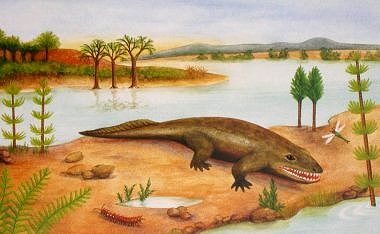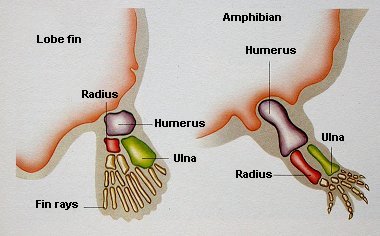
After Pope: Het raadsel van het leven (1986)

After Pope: Het raadsel van het leven (1986)
It is assumed that the quadrupeds descend from a lobe-finned fish or a lungfish, in any case from a fish with bone structure in the fins. Otherwise legs couldn't have developed.
Why did those fishes go ashore? A possible answer is the following: these fishes went ashore to lay their eggs in a safe place, e.g. in a pond. In the open sea countless predators were leering at the spawn to eat it. Some of the lobe-finned fishes had the inclination to crawl on land, which they were able to do because of the bony structure in their fins. Besides they could stay alive outside of the water because they had a good blood circulation in the throat skin which gave them the possibility to absorb oxygen from the air. Lungfishes even had already lungs (and gills too). They laid their eggs in ponds and pools on the land and went back into the water afterwards. This strategy was very successful because there were not yet predators on the land. Read further on the right.
Know more?
Tetrapods (click also the links)
The oldest land animals were amphibians: they passed a great deal of their life in the (fresh)water and laid their eggs also in the water. Natural selection will have caused the gradual transition from lobefins to legs as an adaptation to locomotion on the land. The lungs, too, will have been brought to perfection more and more.
From the above appears that macro-evolution (the occurrence of legs) is not fundamentally different from micro-evolution. The lobefins have evolved gradually to legs.
Recently a new 'missing link' between fishes and quadrupeds has been discovered in Canada, at a distance of 150 km from the North Pole : the animal is called Tiktaalik. Click on the link below to read the story about it (rather sensational!).
Know more?
Meet Tiktaalik
roseae
Tiktaalik